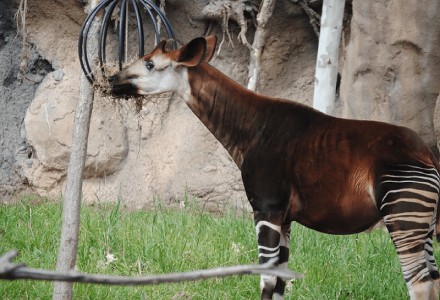
Okapi Facts
- Most notably, the truly remarkable Okapi appears on most lists as the 9th rarest creature on Earth. The animal also, unfortunately, only inhabits a highly specific and limited region.
- Furthermore, many experts consider the remarkable animal to be what is known as a living fossil. They have this opinion due to the fact that it has no known closely related species.
- Finally, genetically, it represents an extremely distant relative of the giraffe, despite its zebra-like markings. Official estimates also place its remaining numbers at fewer than 20,000 individuals.
Related Articles
Saiga Antelope Reindeer Sambar
Okapi Physical Description
Firstly, the distinctive looking Okapi stands roughly 4.9 ft (1.5 m) tall at its shoulder. Being genetically related to the giraffe, it also possesses a comparatively long neck.
An average body also length measures 8.2 ft (2.5 m), although larger individuals do occur. Furthermore, depending on specific individual habitats and diet, adult weights vary between 440 – 770 lb (200 – 350 kg).
In addition, the coat generally presents as either a reddish or chocolate brown color. But the most remarkable feature remains the white horizontal stripes appearing on its legs.
The creature also develops an extremely long, generally purple, tongue. This averages roughly 18 in (45.7 cm) in length.
Its chest, throat, and face generally display a grayish white. In addition, males display very small horns called ossicones.
This remarkable mammal does display sexual dimorphism, but only to a small degree. The females average roughly 1.7 in (4.2 cm) greater in height and lack the tiny horns.
- Kingdom: Animalia
- Phylum: Chordata
- Class: Mammalia
- Order: Artiodactyla
- Family: Giraffidae
- Genus: Okapi
- Species: O. johnstoni
Photographer: kaelin
CC License: https://bit.ly/1dMkpTr
Okapi Distribution, Habitat, and Ecology
The incredible Okapi only exists in the Democratic Republic of the Congo, in Africa. Further, there, it only appears in canopy forests at altitudes between 1,600 – 4,900 ft (500 – 1,500 m). It also occasionally utilizes areas that are seasonally inundated.
The only known populations appear in the northern, central, and eastern portions of the country. In addition, it only inhabits regions east and north of the Congo River.
The astonishing Okapi also has an entirely herbivorous diet. This consists primarily of grass, buds, leaves, ferns, fungi, and various fruits. Finally, it remains unique within its habitat as the only mammal that feeds exclusively on understory vegetation.
Species Sharing Its Range
Cheetah Medusas Head African Penguin
Check out our other articles on 6 Magnificent Carnivorous Plants, Tawny Frogmouth, Vampire Moth, Eye of the Sahara, White Spotted Puffer, Black Banded Sea Krait

